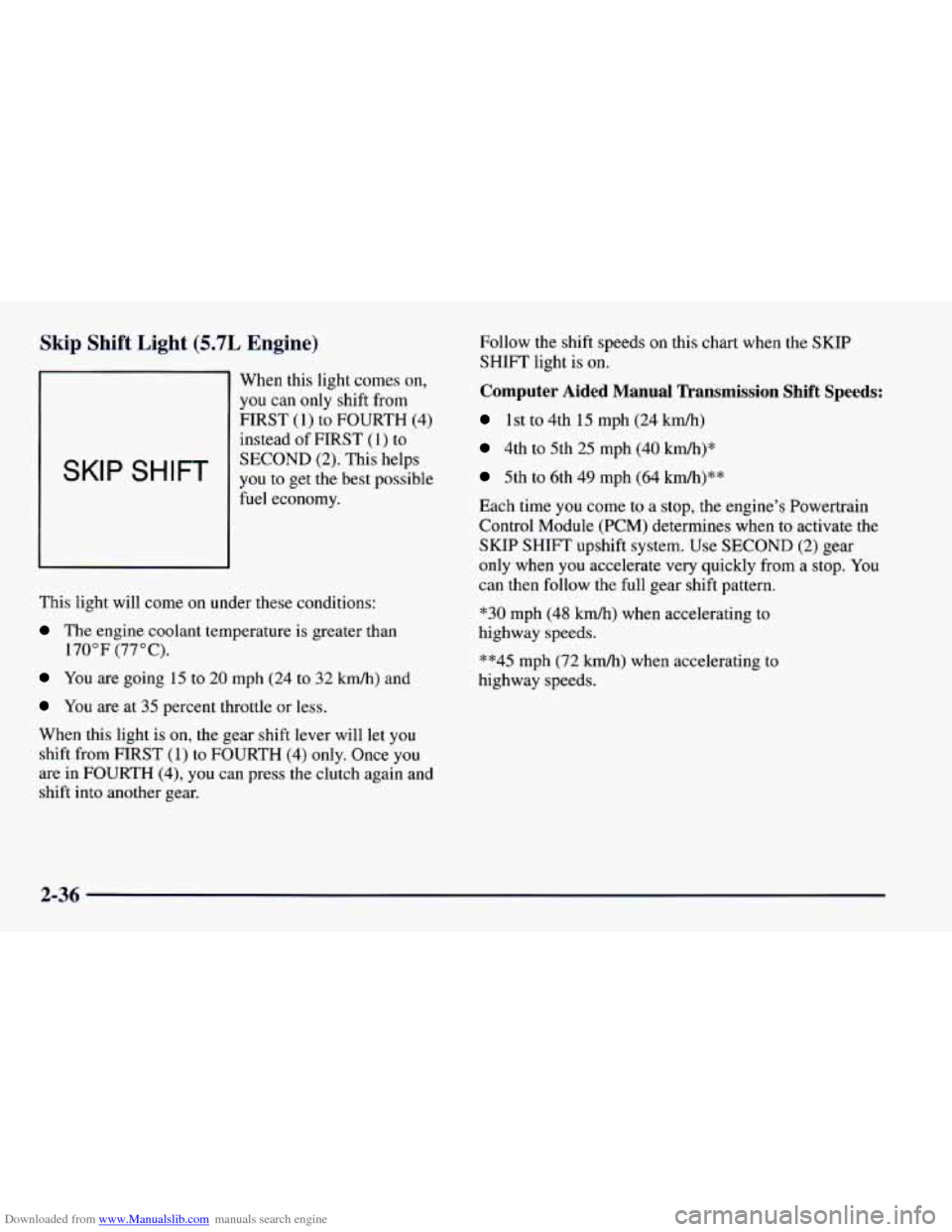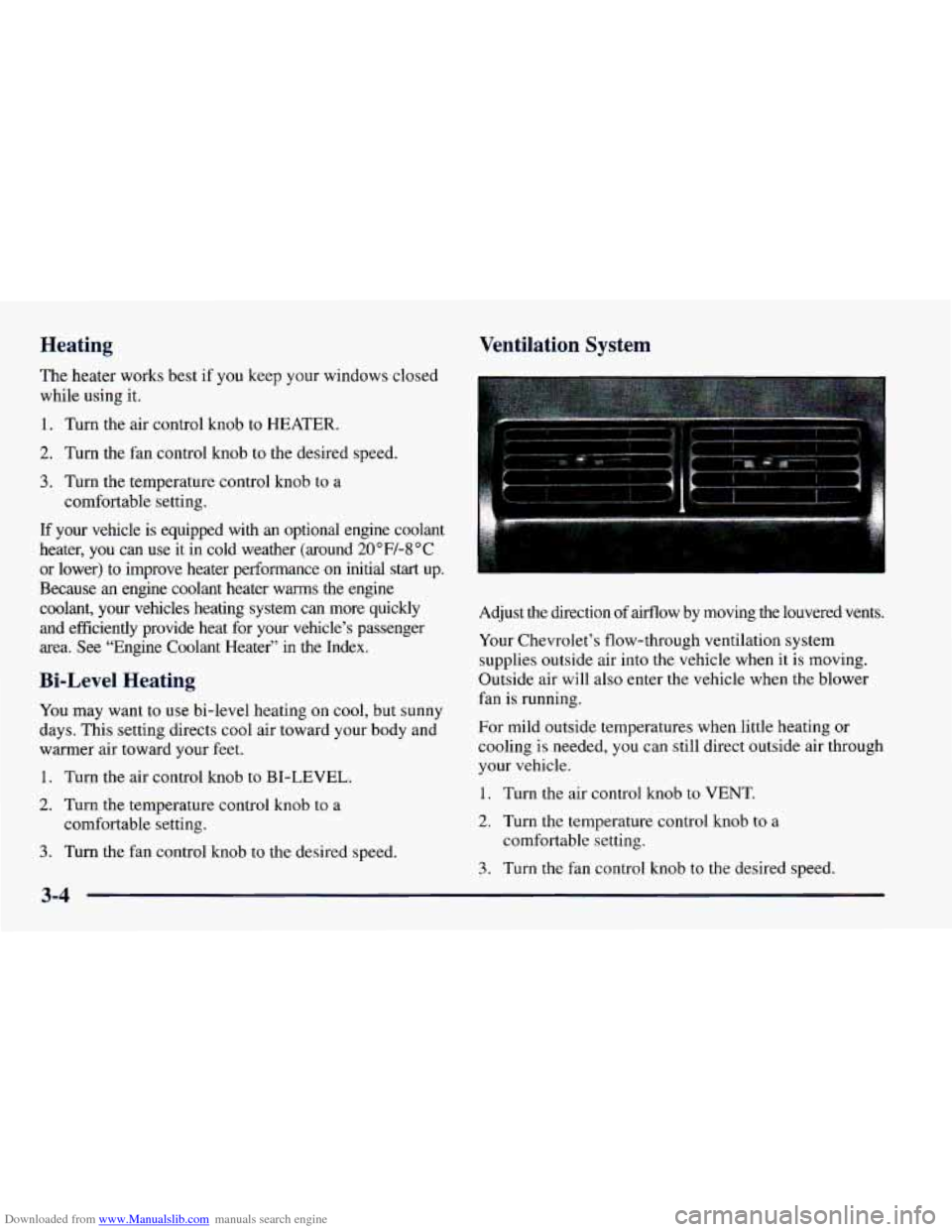Page 10 of 404
Downloaded from www.Manualslib.com manuals search engine Vehicle Symbols
These are some of the symbols you may find on your vehicle.
For example,
these symbols
are used on an
original battery:
POSSIBLE A
CAUTION
INJURY
PROTECT EYES BY
SHIELDING
CAUSTIC
BURNS AVOID
SPARKS
OR
FLAMES
SPARK
OR ,\I/,
COULD FLAME
EXPLODE BAllERY
These symbols
are important
for you and
your passengers
whenever your
vehicle
is
driven:
DOOR LOCK
UNLOCK
FASTEN SEAT
BELTS
These symbols have to
do with
your
lamps:
SIGNALS e a
TURN
FOG LAMPS
$0
These symbols
are
on some of
your controls:
WINDSHIELD
WIPER
WINDSHIELD DEFROSTER
WINDOW
DEFOGGER
These symbols
are used
on
warning and
indicator lights:
ENGINE t
COOLANT
TEMP
-
CHARGING 1-1
BAllERY
SYSTEM
BRAKE
(@)
COOLANT a
ENGINE OIL w,
PRESSURE
ANTI-LOCK
(a)
BRAKES
Here are some other symbols
you may
see:
FUSE
t
LIGHTER m
HORN k3
SPEAKER
Er
FUEL B
...
Page 51 of 404

Downloaded from www.Manualslib.com manuals search engine a Section 2 Features and Controls
Here you can learn about the many standard and optional features on your Chevrolet, and information on starting,
shifting and braking. Also explained are the instrument panel and the warning systems that tell you
if everything is
working properly
-- and what to do if you have a problem.
2-2
2-4 2-7
2-1
1
2-13 2- 14
2-17
2-18
2-23
2- 24
2-26
2-27
2-29
2-32 Keys
Door Locks
Remote Keyless Entry
Hatch
Theft Vehicle and Content Theft-DeterrentIAlarm
System
PASS-Key@
I1
Feature Customization
New Vehicle “Break-In”
Ignition Positions
Starting Your Engine
Engine Coolant Heater
Automatic Transmission Operation
Manual Transmission
2-3 8
2-42
2-42
2-44
2-44
2-45
2-5 2
2-56
2-5
8
2-60
2-6
1
2-6 1
2-68
2-74
2-77 Parking Brake
Parking Over Things That Burn
Engine Exhaust
Windows
Tilt Steering Wheel
Turn Signalhlultifunction Lever
Lamps
Mirrors Storage Compartments
Ashtray and Lighter
Sun Visors
Accessory Plug
Convertible Top
Instrument Panel
Warning Lights, Gages and Indicators
2-1
Page 77 of 404
Downloaded from www.Manualslib.com manuals search engine NOTICE:
Your engine is designed to work with the
electronics in your vehicle.
If you add electrical
parts
or accessories, you could change the way
the engine operates. Before adding electrical
equipment, check with your dealer.
If you don’t,
your engine might not perform properly.
If you ever have to have your vehicle towed, see
the part of this manual that tells how to
do it
without damaging your vehicle. See “Towing
Your Vehicle” in the Index.
Engine Coolant Heater (If Equipped)
In very cold weather, 0°F (- 18OC) or colder, the engine
coolant heater can help. You’ll get easier starting and
better fuel economy during engine warm-up. Usually,
the coolant heater should be plugged in a minimum of
four hours prior
to starting your vehicle.
Page 78 of 404

Downloaded from www.Manualslib.com manuals search engine To Use the Coolant Heater
1. Turn off the engine.
2. Open the hood and unwrap the electrical cord.
3. Plug it into a normal, grounded 1 10-volt AC outlet.
Plugging the cord into an ungrounded outlet
could cause an electrical shock.
Also, the wrong
kind
of extension cord could overheat and cause
a fire. You could be seriously injured. Plug the
cord
into a properly grounded three-prong
110-volt
AC outlet. If the cord won’t reach, use a
heavy-duty three-prong extension cord rated for
at least
15 amps.
4. Before starting the engine, be sure to unplug and
store the cord as
it was before to keep it away from
hot pipes, manifold or moving engine parts. If you
don’t,
it could be damaged.
How long should
you keep the coolant heater plugged
in? The answer depends
on the outside temperature, the
kind
of oil you have, and some other things. Instead of
trying to list everything here, we ask that you contact
your Chevrolet dealer in the area where you’ll be
parking your vehicle. The dealer can give you the best
advice for that particular area.
2-28
Page 86 of 404

Downloaded from www.Manualslib.com manuals search engine Skip Shift Light (5.7L Engine)
When this light comes on,
you can only shift from
FIRST (1) to FOURTH (4)
instead
of FIRST (1) to
SECOND (2). This helps
you to get the best possible
fuel economy.
This light will come on under these conditions:
The engine coolant temperature is greater than
170°F (77°C).
You are going 15 to 20 mph (24 to 32 km/h) and
You are at 35 percent throttle or less.
When this light is on, the gear shift lever
will rer you
shift from FIRST (1) to FOURTH (4) only. Once you
are in
FOURTH (4), you can press the clutch again and
shift into another gear. Follow
the shift speeds
on this chart when the SKIP
SHIFT light is on.
Computer Aided Manual Transmission Shift Speeds:
1st to 4th 15 mph (24 km/h)
4th to 5th 25 mph (40 km/h)*
5th to 6th 49 mph (64 km/h)**
Each time you come to a stop, the engine's Powertrain
Control Module (PCM) determines when to activate the
SKIP SHIFT upshift system. Use
SECOND (2) gear
only when you accelerate very quickly from a stop.
You
can then follow the full gear shift pattern.
"30 mph (48 km/h) when accelerating to
highway speeds.
**45 mph (72 km/h) when accelerating to
highway speeds.
2-36
Page 133 of 404

Downloaded from www.Manualslib.com manuals search engine Engine Coolant Temperature Gage
1
This gage shows the engine
coolant temperature. If the
gage pointer moves into
the red area, your engine
is approaching an
overheating condition.
Low Coolant Light (V8 Engine)
This warning light should
come on briefly while
you
are starting your engine. If
the light doesn’t come on,
m
If you have been operating your vehicle under normal
driving conditions, you should pull off the road, stop
your vehicle and turn off the road as soon as possible.
In “Problems on the Road” this section shows what
to
do. See “Engine Overheating” in the Index. Your
Camaro is equipped with a
LOW COOLANT
indicator that is designed to detect when the coolant
level drops below the set limit.
If the low coolant level
sensor (on the radiator) detects that the level drops while
the engine is running, the
LOW COOLANT indicator
will light and remain lit until the ignition switch is
turned to the
OFF position. Check the coolant level and
add coolant as needed.
2-83
Page 134 of 404

Downloaded from www.Manualslib.com manuals search engine The LOW COOLANT light might stay on after filling
the radiator. Turn the ignition switch to the
OFF
position, then restart the engine to verify that the LOW
COOLANT light goes out. See “Engine Coolant’’ in
the Index.
NOTICE:
Driving with the LOW COOLANT light on could
cause your Chevrolet to overheat. See “Engine
Overheating” in the Index. Your Chevrolet
could be damaged, and it wouldn’t be covered
by your warranty.
Malfunction Indicator Lamp
(Service Engine Soon Light)
SERVICE
ENGINE
SOON
Your Chevrolet is equipped
with a computer which
monitors operation
of the
fuel, ignition and emission
control systems.
This system is called OBD
I1 (On-Board
Diagnostics-Second Generation) and is intended to
assure that emissions are at acceptable levels for the life
of the vehicle, helping to produce
a cleaner
environment. (In Canada,
OBD I1 is replaced by
Enhanced Diagnostics.)
The SERVICE ENGINE SOON
light comes on to indicate that there is a problem and
service is required. Malfunctions often will be indicated
by the system before any problem is apparent. This may
prevent more serious damage to your vehicle. This
system
is also designed to assist your service technician
in correctly diagnosing any malfunction.
2-84
Page 144 of 404

Downloaded from www.Manualslib.com manuals search engine Heating
The heater works best if you keep your windows closed
while using it.
1. Turn the air control knob to HEATER.
2. Turn the fan control knob to the desired speed.
3. Turn the temperature control knob to a
If your vehicle is equipped with an optional engine coolant
heater,
you can use it in cold weather (around 20 “F/-8 “C
or lower)
to improve heater performance on initial start up.
Because an engine coolant heater warms the engine
coolant, your vehicles heating system can more quickly
and efficiently provide heat for your vehicle’s passenger
area.
See “Engine Coolant Heater” in the Index.
Bi-Level Heating
You may want to use bi-level heating on cool, but sunny
days. This setting directs cool air toward your body and
warmer air toward your feet.
1. Turn the air control knob to BI-LEVEL.
2. Turn the temperature control knob to a
3. Turn the fan control knob to the desired speed.
comfortable
setting.
comfortable setting.
Ventilation System
Adjust the direction of airflow by moving the louvered vents.
Your Chevrolet’s flow-through ventilation system
supplies outside air into the vehicle when it is moving.
Outside air will also enter the vehicle when the blower
fan is running.
For mild outside temperatures when little heating or
cooling is needed, you can still direct outside air through
your vehicle.
1. Turn the air control knob to VENT.
2. Turn the temperature control knob to a
comfortable setting.
3. Turn the fan control knob to the desired speed.
3-4